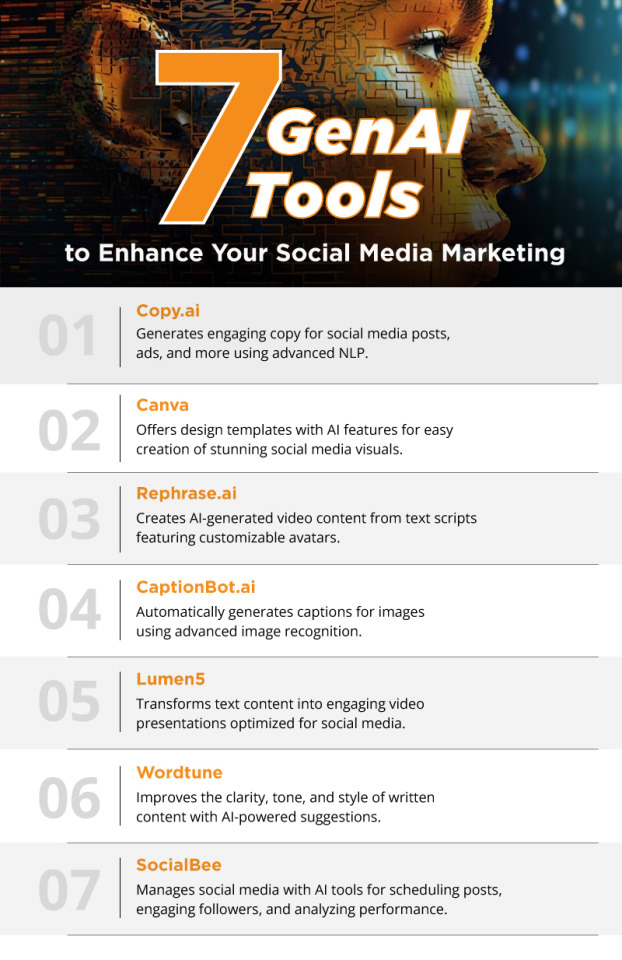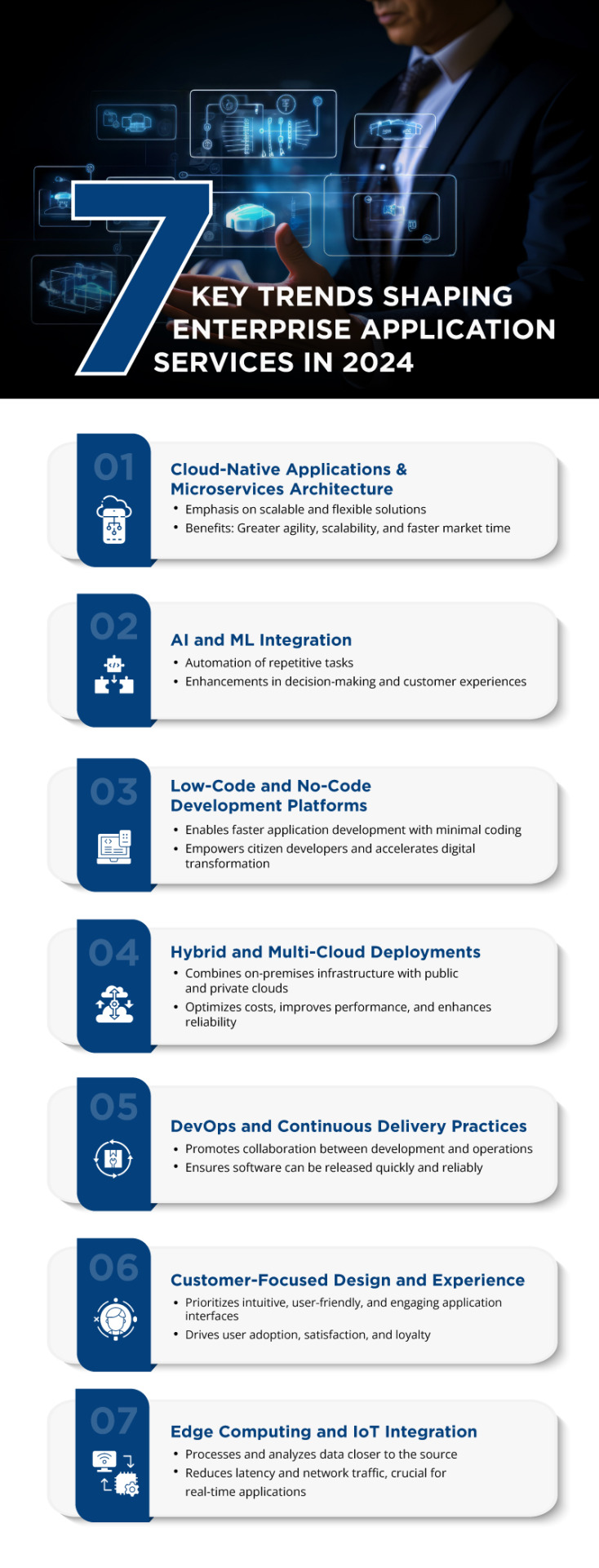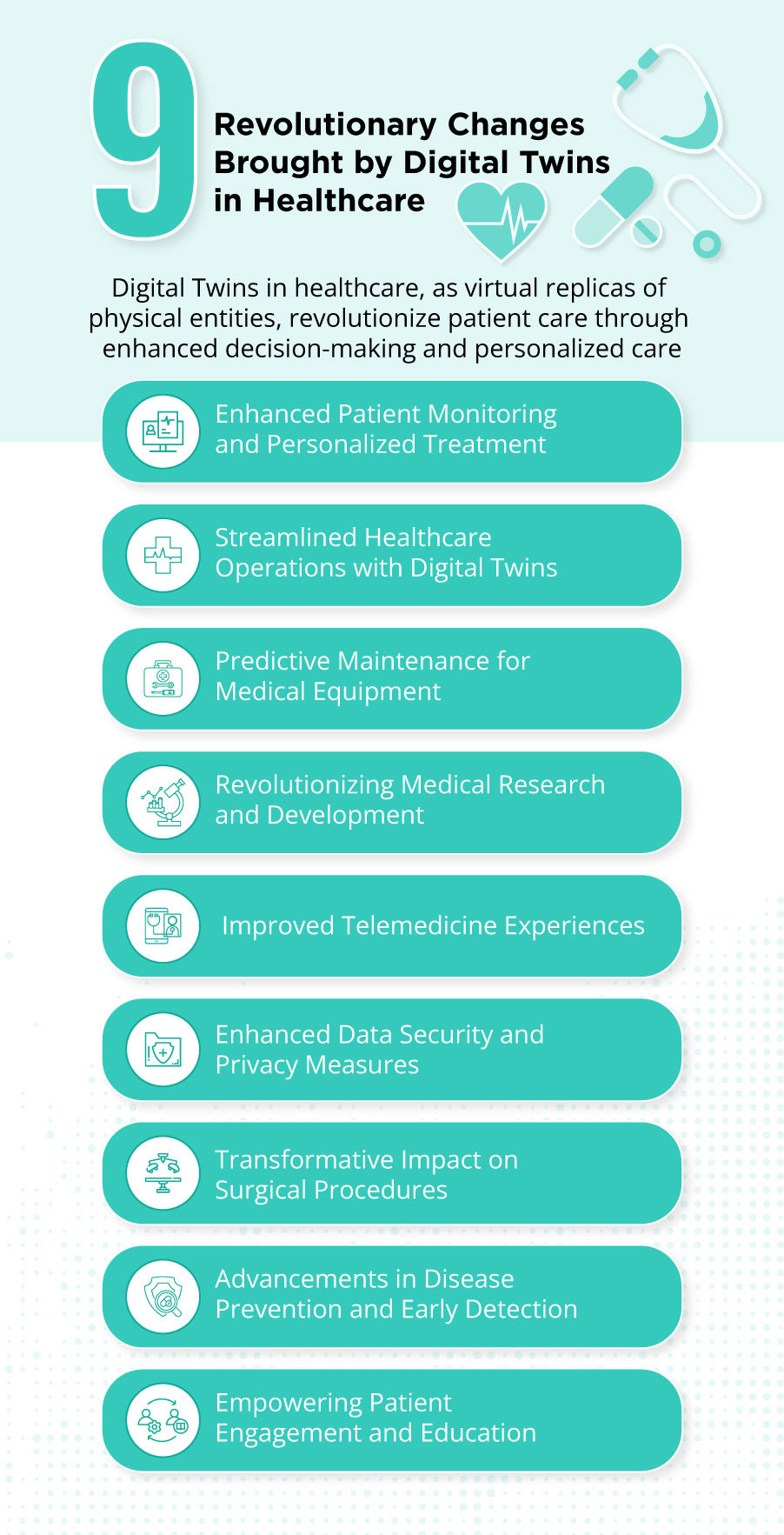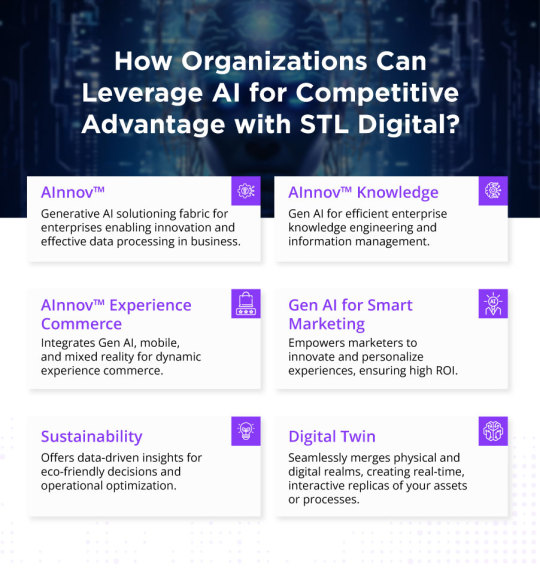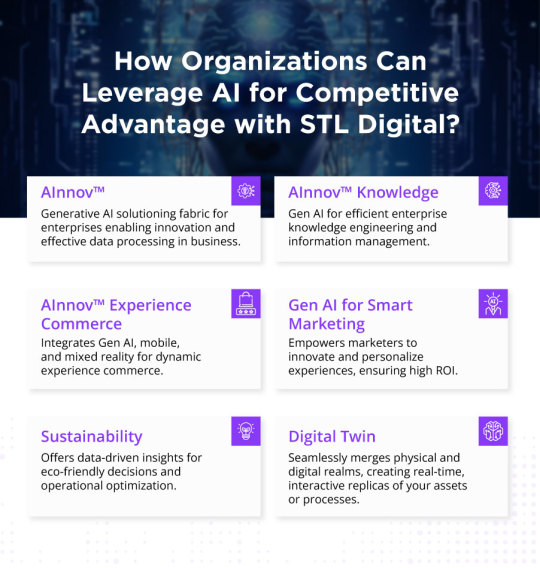Text

In the rapidly evolving landscape of technology, the convergence of artificial intelligence (AI) and green energy has emerged as a transformative force. Understanding the dynamics of AI and green energy is crucial as we strive to create a sustainable future. This blog explores the opportunities and challenges that arise at the intersection of these two domains and shedding light on how STL Digital is spearheading innovation in energy sector.
0 notes
Text

The Impact of 3D Printing Technology on Customized Product Design and Prototyping
0 notes
Text
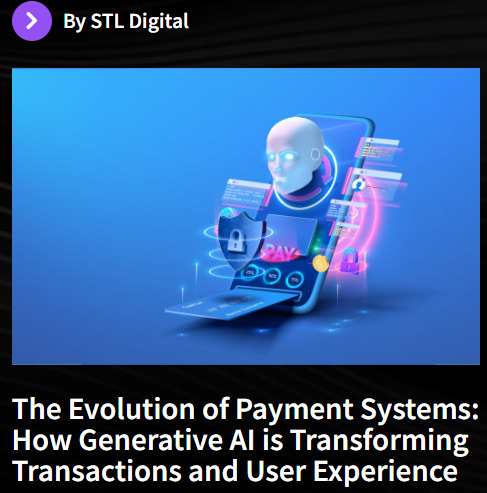
The Evolution of Payment Systems: How Generative AI is Transforming Transactions and User Experience
#cloud first business strategy#cybersecurity solution#data analytics & ai solution#digital experience services
0 notes
Text

The Role of AI in Building Smart Cities: Implications for Urban Development and Governance
0 notes
Text
How STL Digital’s Product Engineering Service Drives Digital Transformation
Introduction
In today’s dynamic and hyper-connected digital landscape, the significance of product engineering cannot be overstated. The product engineering services market is projected to reach $1.5 trillion by 2027. Product engineering is the process of innovating, designing, developing, testing, and deploying products, with a focus on creating solutions that address specific market needs. In the context of the digital era, the importance of product engineering is multi-faceted and extends across various industries. As a leading IT services company, STL Digital specializes in cutting-edge product engineering services, committing to transforming innovative ideas into market-ready solutions. We are dedicated to engineering experiences that redefine industries, combining expertise and innovation to deliver end-to-end product development solutions that position clients for success in today’s dynamic market.
The Role of Product Engineering Services in Digital Transformation
Product engineering services are instrumental in digital transformation, fueling innovation, seamless digital experiences, and interconnected solutions that drive business success in the digital landscape. These services play a pivotal role in crafting cutting-edge products that stay ahead in the competitive market and prioritize user-centric design for engaging digital experiences. The interconnectivity facilitated by product engineering gives rise to ecosystems where devices seamlessly communicate, enhancing user experiences and providing valuable data-driven insights. However, achieving digital success through product engineering requires a strategic approach, aligning the process with business objectives and market demands. This ensures that product engineering becomes a proactive force, anticipating and meeting the challenges of the dynamic digital landscape.
STL Digital’s Product Engineering Services
In the realm of product engineering, STL Digital distinguishes itself with unparalleled expertise in product lifecycle management, guiding the creation of innovative products, digital experiences, and interconnected solutions. Fueled by a resilient ecosystem platform and strategic acumen, we actively challenge traditional business models, reshaping the entire business value chain. Our defining strength lies not merely in product creation but in the unparalleled ability to transform ideas into market-ready solutions. With adept product lifecycle management skills, we specialize in crafting distinctive and innovative products, delivering superior digital experiences, and establishing interconnected solutions that redefine industry benchmarks. At STL Digital, our commitment extends beyond engineering products; we engineer experiences that consistently surpass the evolving demands of the digital landscape.
The Approach to Product Engineering at STL Digital
The Approach to Product Engineering at STL Digital is defined by four key elements, each contributing to the acceleration of innovation and the creation of advance solutions:
Embedded AI for Accelerated Journeys: Utilizing Embedded AI accelerates product engineering, expediting the journey from concept to market.
Engineering Automation with Continuous Feedback: Automation, coupled with continuous feedback, streamlines processes, ensuring adaptability in an iterative development cycle.
Multi-stakeholder Experience Measurement Framework: Integration of a comprehensive framework considers diverse perspectives, guaranteeing a universally satisfactory user experience.
Cloud FinOps Integrated with Product Engineering Services: Embracing Cloud FinOps optimizes resources, ensuring cost-effectiveness throughout the product engineering lifecycle.
Driving Digital Transformation with Modern Technology Trends:
In the swiftly evolving realm of digital transformation, integrating modern technology trends is crucial to expedite innovation and maintain a competitive edge. It is important to understand the steps to Balance Cost and Quality in Product Engineering. By actively adopting and assimilating the latest advancements, organizations can streamline operations, positioning themselves as leaders in delivering state-of-the-art products and services. At STL Digital, we acknowledge the pivotal role of these trends as catalysts for change, not only enhancing efficiency but also paving the way for groundbreaking solutions. Our approach is meticulously calibrated to resonate with the voice of the customer, ensuring that the solutions we engineer leave a lasting and meaningful impact.
Case Studies and Success Stories:
In a dynamic landscape where data integrity is paramount, STL Digital emerged as a game-changer for a leading global credit reference agency facing critical challenges. With a presence in 24 countries and a client base spanning diverse industries, the agency sought to elevate its services amidst growing competition. STL Digital seamlessly addressed two pivotal risks – the need for skilled testing professionals and the synchronization of testing and development timelines. Leveraging modern tools and methodologies, STL Digital crafted a comprehensive Testing Strategy and Test Plan, outlining project milestones and resource allocations. The result? A resounding success with 95%+ test coverage, 85%+ test automation coverage, and a remarkable 90% defect closure rate within two weeks of identification. Client satisfaction soared beyond 95%, underscoring STL Digital’s prowess in delivering premium testing services that not only met but exceeded expectations.
Benefits of Choosing STL Digital for Product Engineering Services
Choosing STL Digital for your product engineering services unlocks a myriad of benefits. Our expertise, unwavering commitment to innovation, and ability to deliver market-ready solutions set us apart in the industry. Research shows almost 66% of customers expect companies to predict and understand their needs and deliver products that will not only meet their specific needs but also offer a personalized experience. We go beyond conventional service delivery by redefining business value chains, disrupting legacy models, and positioning our clients for sustained success in the ever-evolving digital era. Partner with STL Digital for a transformative journey that propels your business to new heights.
Conclusion
By fostering collaboration, aligning goals, and driving innovation, engineering product services are revolutionizing the way IT and business work together. Product engineering is the cornerstone of digital transformation, and STL Digital stands as your trusted partner on this transformative journey. Our commitment to engineering experiences, coupled with a strategic and innovative approach, positions us as the catalyst for businesses aiming to thrive in the digital landscape. Consider STL Digital as your ally in turning ideas into market-ready products that redefine industries and drive digital success.
#cybersecurity solution#data analytics & ai solution#cloud first business strategy#cybersecurity#enterprise saas services#digital
0 notes
Text
10 Biggest Cybersecurity Attacks in Indian History – Part 2
Welcome back to our exploration of the most significant cybersecurity attacks in Indian history. If you haven’t already, make sure to read Part 1 [here].
Cybersecurity threats have evolved into a relentless force, testing the resilience of nations and institutions worldwide. In India, a nation on the cusp of a digital revolution, safeguarding against cyber threats is paramount. In this continuation, we unravel five more biggest cyber incidents that have left an indelible mark on India’s cybersecurity landscape. Each incident serves as a testament to the critical need for unwavering vigilance and cutting-edge cybersecurity measures. Let’s delve into these significant events that have shaped the nation’s digital security posture.
Cybersecurity Attack #6: Bengaluru ATM Hack (2016)
In 2016, Bengaluru, the tech hub of India, witnessed a significant cybersecurity incident that sent shockwaves through the nation’s financial sector. Cybercriminals exploited vulnerabilities within the city’s ATM network, employing a combination of malware injection and social engineering tactics. This allowed them to gain unauthorized access to ATMs, enabling them to discreetly siphon off significant amounts of money. This incident served as a stark reminder of the need for enhanced security measures within the financial sector. By prioritizing security protocols and adopting cutting-edge technology, STL Digital fortifies financial institutions against evolving cyber threats.
Cybersecurity Attack #7: Operation Hangover (2014)
In 2014, “Operation Hangover” targeted Indian government officials and military personnel, stealing sensitive data. The attack, attributed to the “Lords of Dharmaraja,” used spear-phishing and stealthy navigation to exfiltrate information. This breach underscored the need for enhanced cybersecurity in government and military sectors, leading to lessons in vigilant training, real-time monitoring, segmented networks, regular audits, collaboration, and incident response planning.
By prioritizing extra vigilant systems, real-time incident response, and intelligence-based threat detection, STL Digital empowers these sectors to navigate the complex cyber threat landscape. Real-time Incident Response.
Cybersecurity Attack #8: Syrian Electronic Army Attack (2014)
In 2014, India faced a cyber threat from the Syrian Electronic Army (SEA), a hacktivist group known for supporting the Syrian government through digital activism. The SEA targeted Indian news websites and social media accounts, defacing them with politically motivated messages. This incident raised concerns about the vulnerability of India’s digital infrastructure to international hacktivist groups, prompting a reevaluation of security measures within media organizations and the broader digital ecosystem.
This incident highlighted the critical need for heightened security measures within media outlets and proactive threat intelligence gathering. STL Digital recognizes the evolving nature of cyber threats and offers tailored solutions for media industry with our cybersecurity and digital rights management (DRM) solutions.
Cybersecurity Attack #9: Kudankulam Nuclear Power Plant Malware (2019)
In 2019, a significant malware attack targeted the Kudankulam Nuclear Power Plant in Tamil Nadu, India. Reports indicated that the breach may have gone undetected for over six months, highlighting the critical need for robust cybersecurity measures in safeguarding vital infrastructure. Although the exact method of attack remains confidential, it is believed that the malware infiltrated the plant’s computer systems, potentially exploiting vulnerabilities in software or networks.
This incident served as a poignant reminder of the potential vulnerabilities even within the most sensitive installations, emphasizing the need for robust cybersecurity measures. STL Digital’s IoT and System Cyber Security offerings, empower a Safe, Intelligent, and Sustainable Future for the Energy, Resources and Utilities enterprises.
Cybersecurity Attack #10: NIC Email Hack (2012)
In 2012, the National Informatics Centre (NIC) faced a significant cybersecurity breach when its email system was hacked, compromising sensitive government communications. The breach, believed to involve advanced phishing techniques or email infrastructure vulnerabilities, highlighted the need for enhanced email security, employee training in cybersecurity, real-time monitoring, incident response planning, and inter-agency collaboration.
This incident highlighted the vulnerabilities within critical government institutions, emphasizing the ever-evolving nature of cyber threats.
Common Themes and Patterns
Analyzing the landscape of cybersecurity attacks in India reveals several recurring patterns. One prominent trend is the escalating frequency and sophistication of ransomware attacks. Cybercriminals increasingly favor this method, encrypting critical data and demanding a ransom for its release. Additionally, targeted attacks on critical infrastructure have emerged as a significant concern. This trend underscores the imperative for fortified security measures in sectors vital to the nation’s functioning, including power, telecommunications, and transportation.
When it comes to vulnerabilities and targets, an examination reveals common points of exploitation. Outdated and unpatched software remains a prime vulnerability. India has made commendable progress in cybersecurity, forming robust policies and protocols through collaborative efforts between the government, the private sector, and experts. Dedicated cybersecurity centers and a skilled workforce are crucial steps in bolstering the nation’s cyber resilience.
Conclusion
These ten major cybersecurity attacks in India underscore the dynamic and relentless nature of cyber threats. Each incident underscores the importance of vigilance, preparedness, and swift response. As we navigate the evolving landscape of cyberspace, it is incumbent upon us to remain steadfast in our commitment to safeguarding our digital future. Continuous investment in cutting-edge technologies, stringent adherence to best practices, and collaborative efforts will undoubtedly pave the way for a more resilient and secure India in the digital age.
STL Digital offers a shield against the ever-present threat of cyber-attacks with our Cybersecurity services. With robust access controls, minimized attack surfaces, and security integrated throughout development, we ensure comprehensive protection. Choose STL Digital for a safeguarded digital journey.
#cloud first business strategy#cloud solution#enterprise saas services#data analytics & ai solution#cybersecurity#digital
0 notes
Text
AI-Generated Faces: How Generative Models Are Changing Visual Content Creation
Generative models are powerful tools that are being used to create increasingly realistic AI-generated faces. These models can learn from large datasets of images and then use that knowledge to generate new images that are similar to the ones they have seen.
Although generative AI models are still under development, but they have already made significant progress in creating realistic AI-generated faces. As these models continue to develop, they are likely to become even more powerful tools for creating visual content.
How Do Generative AI Models Create Faces
The process of generating AI-generated faces with generative models typically involves the following steps:
Data collection: A large dataset of images of human faces is collected. This dataset should be as diverse as possible, including images of people of different ages, genders, races, and ethnicities.
Data preprocessing: As the next step in creating AI-generated faces, the images in the dataset are preprocessed to ensure that they are all of the same size and format. This is important so that the generative model can learn from the data effectively.
Model training: The generative model is trained on the preprocessed data. This process involves feeding the model the images in the dataset and allowing it to learn the patterns and relationships between the pixels in the images.
Image generation: Once the model has been trained, it can be used to generate new images of human faces. This is done by providing the model with a seed image or a set of parameters that describe the desired image.
The current state of AI-generated faces is rapidly evolving, with advancements being made in both realism and versatility. Generative adversarial networks (GANs) have played a pivotal role in this progress, enabling the creation of incredibly lifelike faces that can often be indistinguishable from real ones.
Realism of AI-Generated Faces
The realism of AI-generated faces has reached an impressive level, with some models capable of producing images that are nearly identical to photographs of real people. These synthetic faces exhibit intricate details, such as subtle skin textures, hair strands, and even the micro-expressions that convey emotion.
Some notable achievements in AI-generated faces include:
GANimation: This technique allows for the animation of AI-generated faces, enabling the creation of realistic facial expressions and movements.
StyleGAN2: This model introduced a new approach to GAN training, resulting in the generation of highly diverse and realistic facial features.
StyleGAN-ADA: This model further enhanced the realism of AI-generated faces, particularly in capturing the subtle variations in facial expressions and emotions.
AI-Generated Faces with Attributes: GANs have also been used to generate faces with specific attributes, such as age, gender, ethnicity, and hairstyle.
AI-Generated Faces from Text Descriptions: Recent research has explored the possibility of generating faces from text descriptions, allowing for the creation of faces based on verbal prompts.
Despite the remarkable progress, challenges remain in creating AI-generated faces that are truly indistinguishable from real ones. Subtle imperfections, such as inconsistencies in lighting, skin texture, and hair rendering, can still reveal the synthetic nature of the images.
Use Cases of AI-generated Faces for Visual Content
AI-generated faces are having a significant impact on industries like film, advertising, and gaming, offering creators new possibilities for visual storytelling and character development. Here’s a closer look at their influence in each industry:
Film
AI-generated faces can reduce production costs by eliminating the need for hiring actors and makeup artists for certain roles, particularly background characters or crowd scenes. AI can create realistic digital doubles of actors for scenes that require aging or special effects, saving time and money on makeup and prosthetics. AI-generated faces can also be used to create virtual stunt doubles for dangerous or physically demanding action sequences, enhancing safety and reducing the risk of injuries.
Advertising
AI can generate diverse and personalized facial representations for targeted advertising campaigns, increasing relevance and engagement. In addition, AI-generated faces can convey a wide range of emotions and expressions, enhancing the storytelling power of advertisements. AI can also create virtual spokespersons or influencers with tailored personalities and appearances, expanding marketing reach and appeal.
Gaming
AI can generate highly realistic facial models for video game characters, enhancing immersion and player engagement. AI can create a vast array of unique and diverse NPCs (non-player characters) for open-world games, adding realism and replayability. AI can enable more dynamic and emotionally responsive interactions between players and NPCs, enhancing the gaming experience.
As AI-generated faces become increasingly realistic, it’s crucial to consider the ethical implications of this technology. Here are some key ethical considerations and potential misuses that need to be addressed:
Potential Misuses
If there are helpful applications of AI-generated faces, there are possibilities of exploitation by cybercriminals as well.
Deepfakes for Propaganda or Disinformation – AI-generated faces could be used to create deepfakes of politicians, celebrities, or other public figures, spreading misinformation or propaganda to influence public opinion or disrupt elections.
Fake Profiles and Social Media Manipulation – They could be used to create fake social media profiles, engage in catfishing, or manipulate online interactions for malicious purposes.
Non-Consensual Intimate Image Generation – AI-generated faces could be used to create non-consensual intimate images, also known as “revenge porn,” causing psychological harm and violating individuals’ privacy.
Identity Theft and Financial Fraud – Cybercriminals can also create fake identities for financial fraud, such as opening bank accounts or applying for loans under false pretenses using AI-generated faces.
How to Mitigate Ethical Issues
As the AI-driven content creation landscape becomes more complex to navigate, here are some ways we can mitigate the ethical issues that could arise due to the technology’s proliferated usage.
Ensuring that AI models are trained on diverse and representative datasets can minimize bias and promote fairness. Implementing mechanisms to watermark or make AI-generated faces traceable can help identify and combat deepfakes or misuse.
Educating the public about AI-generated faces, their capabilities, and potential misuses will help promote responsible use and prevent misuse. One of the most effective and urgent steps would be establishing clear regulations and oversight frameworks to govern the development and use of AI-generated faces, ensuring ethical and responsible practices.
To Wrap Up This Discussion
The only way now is forward when it comes to generative AI models and content creation using AI-generated faces. However, responsible usage is of paramount importance if we are to leverage modern AI technologies while ensuring the privacy of all the stakeholders of the new world. AI-generated faces and their applications will only grow, and it’s up to the people who use them to use them the right way.
STL Digital’s experts are well-versed in generative AI technologies and can help you take advantage of the latest AI tech without crossing any boundaries not meant to be crossed.
#cloud first business strategy#cybersecurity solution#enterprise saas services#digital experience services#cybersecurity#digital
0 notes
